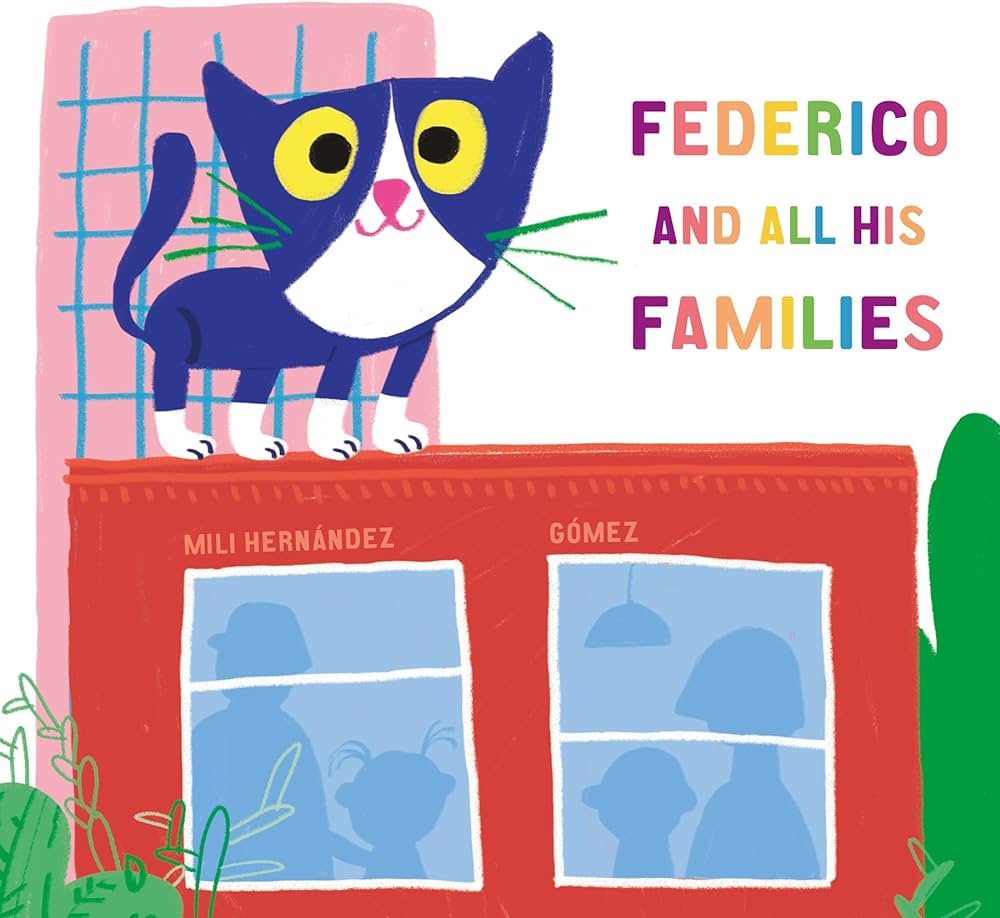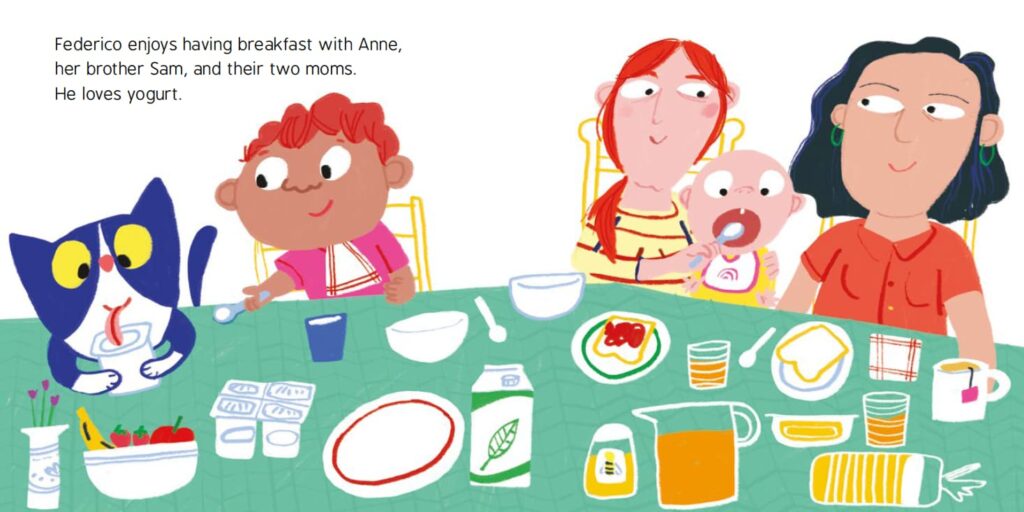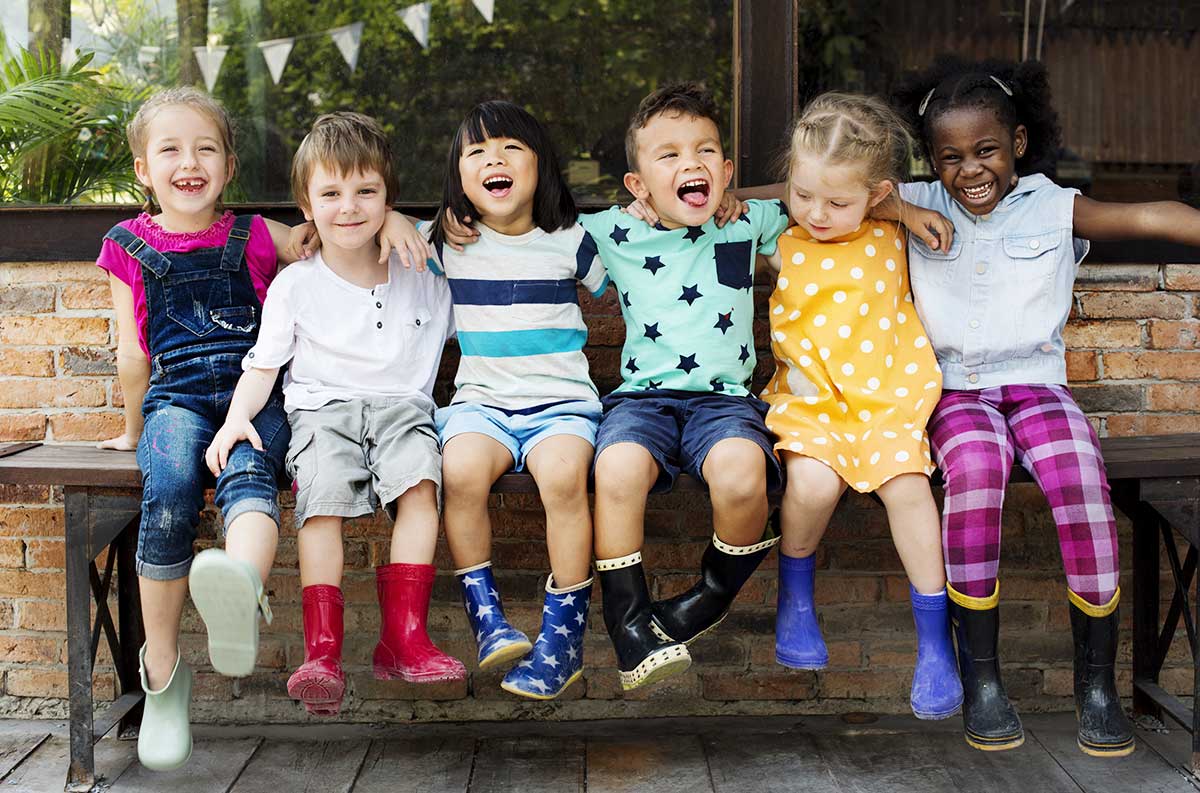
Inclusive Children's Book Teaching Guide
Federico and All His Families
What is this book about?
Traveling from roof to roof, Federico the cat visits all of his families every day: Tadeo and his grandparents; Anna and her two moms; Virginia, with her mom and dad; Paula and her two dads. All of these families are different, but Federico loves them unconditionally.
Over the course of this story, Federico checks in with each family to see what the family members are doing. The story concludes with Federico expressing happiness that he is a part of so many different families.
This short board book shows the youngest of children that love can be found in any family.
Who is depicted in this book?
- A variety of families, including families with two moms or two dads
What early childhood themes and concepts does this book explore?
- Familiar daily routines and activities (sharing a meal, brushing teeth, catching the bus, reading)
- Different kinds of families and their members (including Rainbow families)
How does this book support anti-bias education?
As Federico steps into vignettes of everyday life in the homes of the different families, diverse families are described and positively represented in this book, which supports the development of family pride and positive social identities.
Depending on how the book is shared or used—and the developmental level of the children—Federico and All His Families may be used to support the following core goal from Anti-Bias Education for Young Children and Ourselves:
Identity—Teachers will nurture each child’s construction of knowledgeable and confident personal and social identities so that the children will demonstrate self-awareness, confidence, family pride, and positive social identities.
How can this book be used to meet early childhood learning standards?
For all ages
Use Federico and All His Families to meet early childhood literacy standards
For children from birth to age three
Teaching suggestion: Point out familiar settings and objects in the story. Encourage the children to point out or name the various locations and objects featured in Federico’s adventures. Observe and respond as the children react to and describe the illustrations.
What Illinois Early Learning Guideline does this meet for children from birth to age three?
Developmental DomainSocial-Emotional Development
Standard: Relationship with PeersChildren demonstrate the desire and develop the ability to engage and interact with other children.
Indicators for children:
- Begins to engage in parallel play, in closer proximity to other children but no interaction is attempted (7–18 months)
- Begins to engage in simple reciprocal interactions such as rolling a ball back and forth (16–24 months)
- Demonstrates a preference for select peers (21–36 months)
Teaching suggestion: Point to and name the various family members in the story, using names that the children will recognize.
What Illinois Early Learning Guideline does this meet for children from birth to age three?
Developmental DomainLanguage Development, Communication and Literacy
Standard: Expressive CommunicationChildren demonstrate the ability to understand and convey thoughts through both nonverbal and verbal expression.
Indicators for children:
- Utters first words for familiar objects and people (7–18 months)
Teaching suggestion: Encourage the children to talk about and imitate Federico as he participates in different family activities.
What Illinois Early Learning Guideline does this meet for children from birth to age three?
Developmental DomainLanguage Development, Communication and Literacy
Standard: Early LiteracyChildren demonstrate interest in and comprehension of printed materials.
Indicators for children:
- Imitates gestures and sounds during activities (7–18 months)
- Repeats familiar words in a book while being read to (16–24 months)
Teaching suggestion: Identify and ask questions about the family routines depicted in the illustrations. Which ones are familiar to the children in your classroom?
What Illinois Early Learning Guideline does this meet for children from birth to age three?
Developmental DomainCognitive Development
Standard: Logic and ReasoningChildren demonstrate the ability to use knowledge, previous experiences, and trial and error to make sense of and impact their world.
Indicators for children:
- Imitates adult’s body language and simple actions, such as putting hands on hips or pretending to brush crumbs off table (7–18 months)
- Understands functionality of objects, e.g., mop is used to clean the floor (16–24 months)
- Makes a prediction of what will happen next in a sequence of events (24–36 months)
For preschoolers (ages three to five)
Teaching suggestion: Encourage the children to describe the everyday routines that Federico encounters.
What Illinois Early Learning and Development Standards does this meet for preschoolers?
Language Arts Standard1EUse increasingly complex phrases, sentences and vocabulary.
Benchmark 1.E.ECa:
With teacher assistance, begin to use increasingly complex sentences.
Benchmark 1.E.ECb:
Exhibit curiosity and interest in learning new words heard in conversations and books.
Benchmark 1.E.ECd:
With teacher assistance, explore word relationships to understand the concepts represented by common categories of words (e.g., food, clothing, vehicles).
Teaching suggestion: Invite the children to talk about different family structures. Ask: "Who is in your family? What is the same and different among families? What is something great about your family?" Incorporate families into pretend play and art projects.
What Illinois Early Learning and Development Standards does this meet for preschoolers?
Social Studies Standard18BDevelop an awareness of self within the context of family.
Benchmark 18.B.ECa:
Understand that each of us belongs to a family and recognize that families vary.
See inside this book.

